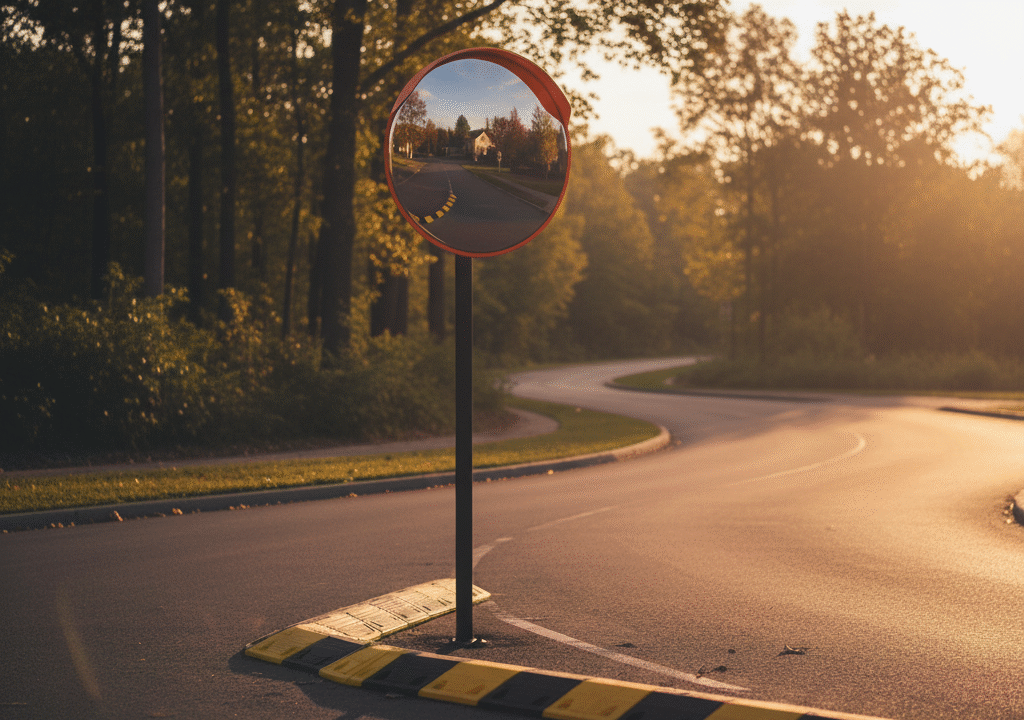Why Road Safety Tools Matter
Road safety is a global priority. Road traffic crashes cause approximately 1.19 million deaths annually worldwide (WHO). Low-cost, high-impact tools such as speed bumps and convex road mirrors help reduce speeds, eliminate blind spots, and prevent collisions in high-risk zones.
What Speed Bumps Do
Speeding is a leading factor in severe crashes. According to NHTSA, it contributed to around 29% of U.S. traffic fatalities in 2022. Properly designed speed bumps are a proven way to calm traffic.
Key benefits
- Lower speeds where it matters — studies show reductions of up to 40% in high-risk zones.
- Fewer injuries — neighborhoods with traffic calming see child pedestrian injuries reduced by ~50%.
- Driver alertness — vertical deflection forces drivers to pay attention.
- Protects schools, hospitals, and crossings — especially effective in mixed traffic and pedestrian areas.
How Convex Road Mirrors Help
Blind spots at sharp bends, T-junctions, and narrow entrances cause avoidable collisions. Convex mirrors expand the visual field so drivers can detect oncoming traffic or pedestrians earlier.
Benefits
- Wider field of view — up to ~160° coverage depending on size and placement.
- Fewer intersection crashes — reported 20–30% reductions where mirrors address sight-line limits.
- Warehouse & parking safety — reduces vehicle-to-pedestrian and forklift incidents.
- Deters theft — added passive surveillance effect for entrances and aisles.
Key Statistics at a Glance
- 1.19M global road deaths annually (WHO).
- 29% of U.S. traffic fatalities involved speeding (NHTSA, 2022).
- Up to 60% reduction in injury crashes where traffic calming is implemented (ITE case studies).
- 20–30% collision reduction reported after adding convex mirrors at dangerous intersections.
Note: Results vary by design, placement, enforcement, and local context.
Where to Install Them
Speed Bumps
- School zones & playground perimeters
- Hospital and clinic access roads
- Residential streets and gated communities
- Industrial sites, logistics yards, and warehouses
- Shopping centers & valet parking areas
Convex Mirrors
- Sharp bends, T-junctions, narrow streets
- Car park ramps, pillars, and blind aisles
- Loading docks and warehouse intersections
- Driveway exits with obstructed sight lines
- Security-sensitive corridors and corners
Speed Bumps vs. Convex Mirrors
| Feature | Speed Bumps | Convex Mirrors |
|---|---|---|
| Primary purpose | Reduce speed | Eliminate blind spots |
| Best locations | Schools, crossings, car parks | Intersections, ramps, bends |
| Effect on flow | Physical slowing | Visual awareness |
| Maintenance | Periodic bolt checks; repainting markings | Cleaning; periodic alignment checks |
Why Businesses & Communities Should Invest
- Liability reduction — fewer incidents, fewer claims.
- Customer trust — safer, easier navigation in car parks.
- Worker protection — fewer forklift and backing incidents.
- High ROI — low acquisition cost, long-term safety gains.
FAQs
What speed bump height is recommended?
Common profiles range from 35–75 mm. Choose profiles that meet local regulations and match your target speed (e.g., 10–25 km/h for car parks and school zones).
What size convex mirror should I use?
Typical outdoor diameters are 60–100 cm. Larger mirrors give wider fields of view (up to ~160°) and are preferable at longer sight distances.
How should I position a convex mirror?
Mount at driver eye-level with slight downward tilt. Ensure the mirror is visible before the decision point and not obstructed by signs or foliage.
Do I need signage or paint with speed bumps?
Yes. Use warning signs, high-contrast paint, and reflectors (cat eyes) for night visibility. Mark the bump edges clearly to reduce harsh braking.
Get a Site Safety Assessment
Want help choosing the right speed bumps and convex road mirrors for your site? Our team can survey your location and recommend compliant, cost-effective solutions.


